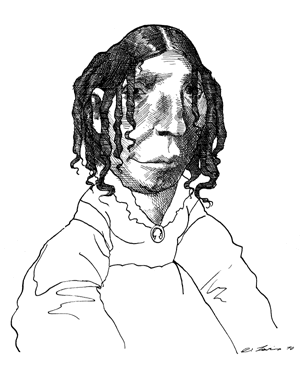As editorial editor of The New York Times Gail Collins is responsible for seeing that writers get to the point and get to it quick—ASAP, as the current lingo would have it. She herself gets to the point ASAP on the opening page of her long, ambitious history of America’s women:
The history of American women is all about leaving home—crossing oceans and continents, or getting jobs and living on their own. Some of our national heroines were defined by the fact that they never nested—they were peripatetic crusaders like Susan B. Anthony, Clara Barton, Sojourner Truth, Dorothea Dix. The center of our story is the tension between the yearning to create a home and the urge to get out of it.
Animated by that tension and willing to dramatize it in a multitude of examples, Ms. Collins has produced a rapid, readable, polyglot history of womenfolk in America, a book that seethes and bubbles with information. If the juxtapositions she throws up sometimes seem capricious, the facts are mostly fascinating. In only the third paragraph we learn that Louisa Adams, wife of John Quincy, was so miserable as First Lady that she spent much of her time eating chocolates, although as a diplomat’s wife and a young mother she had crossed Russia during the Napoleonic Wars in a carriage with her young son. And then, same paragraph, hardly pausing for breath, Ms. Collins informs us that during World War II female aviators risked their lives pulling targets for unpracticed gunners to shoot at—the same females were subject to arrest if they tried to leave the base after dark wearing slacks.
If one paragraph can accommodate two such diverse pieces of information, how much pith can we expect 450 pages to yield? Gail Collins of course is well aware that she is practicing bullet-train history. The hundreds of mysteries, puzzles, enigmas, conundrums, and ambiguities which litter our historical landscape are not all going to be tidily resolved by Ms. Collins or, probably, anyone else. For those who want to make a deeper investigation of some of these matters a generous eighty-seven pages of notes and bibliography are provided. We are frequently reminded that there are many silences in our history, some of them involving women who were so appalled by what they had got themselves into that they made no report at all.
This shroud of silence is wrapped most closely around the first European and African women to arrive on American shores. Thanks to the discovery in the 1960s of the eleventh-century Norse site at L’Anse aux Meadows, in Newfoundland, it now seems that the first European child to be born on the soil of this continent was little Snorri Karlsefni. Ms. Collins mentions the Vikings but is more concerned with the first females to arrive in Virginia and Massachusetts.
What became of Virginia Dare, daughter of Eleanor Dare, who arrived to join the Roanoke colony just in time to give birth to Virginia? Mother and daughter and, for that matter, the rest of the Roanoke colony were simply swallowed up by the wilderness. This was in 1587.
Virginia Dare was a wisp, arriving only to vanish. A more haunting figure, for my money, was Dorothy May Bradford, one of nineteen women to arrive on the Mayflower, after a dreadfully hard voyage. The ship finally made anchor and a party went ashore to investigate, among them Dorothy’s husband, William Bradford, leader of the group. The women stood on deck and looked at this somber land they had traveled to. Dorothy May then either slipped and fell overboard, or flung herself overboard and drowned, daunted beyond endurance by the bleakness of the prospect. Her husband naturally preferred to believe she slipped. Cotton Mather tactfully reported that she slipped, but Ms. Collins thinks she jumped. Her eighteen female shipmates made no report—by the following spring fourteen of the eighteen were as dead as Dorothy.
For many, the new land was simply too much. The writer Kirkpatrick Sale, in The Conquest of Paradise,* his study of Columbus and his legacy, thinks that the high rate of mortality among the earliest settlers was partly the result of something he calls “wilderness shock.” A healthy colonist might come ashore, and, once ashore, be simply stunned by the prospect that greeted him. The new arrivals looked, they weakened, they sat down, they died.
The one endlessly recurring theme in Ms. Collins’s book is the fact of early mortality. American women nowadays, who fret because their fortieth birthday is coming, can comfort themselves with the thought that today forty is more or less the midpoint; in earlier centuries reaching forty would have been a fine—and a rare—achievement. In the seventeenth, eighteenth, and nineteenth centuries, to reach forty meant that wilderness, disease, accident, and violence had somehow spared you. Childbirth alone accounted for endless thousands; in New England in the eighteenth century about a fifth of all mothers died giving birth, and the ratio was worse in the South.
Advertisement
For many readers the most fascinating parts of this book will not be the obligatory rehash of the battle for suffrage, or the long struggle for more or less equal rights. Some of the most enticing pages deal with the development of what might be called domestic technology. Want to know the history of the diaper, or, more challengingly, of the sanitary napkin? Ms. Collins will enlighten you. She is also frank about the gynecological horrors endured by women almost to the present day. Suffice it to say that colonial New England was not a good place to have a prolapsed uterus.
Throughout, Ms. Collins keeps a keen eye on shifts in sexual behavior. She disputes that the Puritans were prudish, quoting this wise comment from that old, much reprinted sex manual Aristotle’s Masterpiece: “Women choose rather to have a thing done well than have it often.” Or is it so wise? Need the two things be mutually exclusive? When she gets to the South she trots out the diarist Mary Chesnut’s acid comment on the racial makeup of the Southern household: every Southern woman, she remarks, “tells you who is the father of all the mulatto children in everybody’s household, but those in her own she seems to think dropped from the clouds, or pretends to so think.”
Indeed, much the longest and in many ways the richest section of America’s Women—it’s more than one hundred pages long—is her chapters on the South and abolition before and during the Civil War. Luckily for her there’s an abundance of forthright diaries and letters to work with, and, of course, a society rife with tension and complexity. Many well-to-do households contained two women of different races and stations—one slave, one free—who often slept with and produced children by the same man.
Though plenty of diaries and letters having to do with the westering movement are now in print, westering interests Ms. Collins less than the South. She does almost nothing with Native American women, or the Hispanic women of California and the Southwest, although in both instances there were interesting lives to be examined. Most white women captured by Indians suffered horribly, but there were a few examples of what might be called successful captivities. Ms. Collins briefly mentions one of these, that of Olive Oatman, who, with her sister, was captured by Apaches but sold to the Mojaves, with whom she happily raised a family; the same was true of the famous Texas captive Cynthia Ann Parker, mother of Quanah Parker, an extremely handsome and competent war chief whose task it was to lead the Comanches into the reservation era. Like Olive Oatman, Cynthia Ann Parker, once returned to “civilization,” soon wasted away. A little consideration of why “savage” life worked for some few women would not have been amiss.
As I read America’s Women I kept a running tally of women mentioned by name—in the case of slaves perhaps by only one name—and the total came to roughly 475, about one woman to the page. Of course the superstars—Harriet Beecher Stowe, Sojourner Truth, the major suffragettes, Eleanor Roosevelt—get more extended treatment, as do a few exceptional characters such as Elizabeth Blackwell, the first woman to obtain a medical degree from an American medical school. It seems to me that if Ms. Collins had chosen to slow her narrative a bit, and go into even grittier detail, the result might have been fewer rather than more readers. For the story of America’s women is not, by and large, a pleasant one. It’s principally a story of abuse, heavy drudgery, inequality, violence, suffering, and early death; and the distance traveled, in terms of equality, was purchased at a very heavy cost.
Today the situation is far from perfect, but it would be hard to read this book and not conclude that, for women, things have improved. In her day Eleanor Roosevelt exercised great moral influence, but, so far as I know, when FDR died no one considered running her for president against Thomas Dewey. Harry Truman, a likable former haberdasher from Missouri, of whom little was expected, was chosen over perhaps the greatest American woman of her day. Yet now female superpowers abound: Carly Fiorina runs Hewlett-Packard, Madonna casually smashes any barrier put in her way, and is now, to boot, the author of a children’s book (translated into thirty languages) which hit the world market simultaneously in one hundred countries. And Hillary Rodham Clinton has a real chance to win the presidency. She wears slacks, too—but, unlike those female aviators of World War II, no one is rushing to arrest her.
Advertisement
This Issue
November 20, 2003
-
*
Knopf, 1990. ↩



